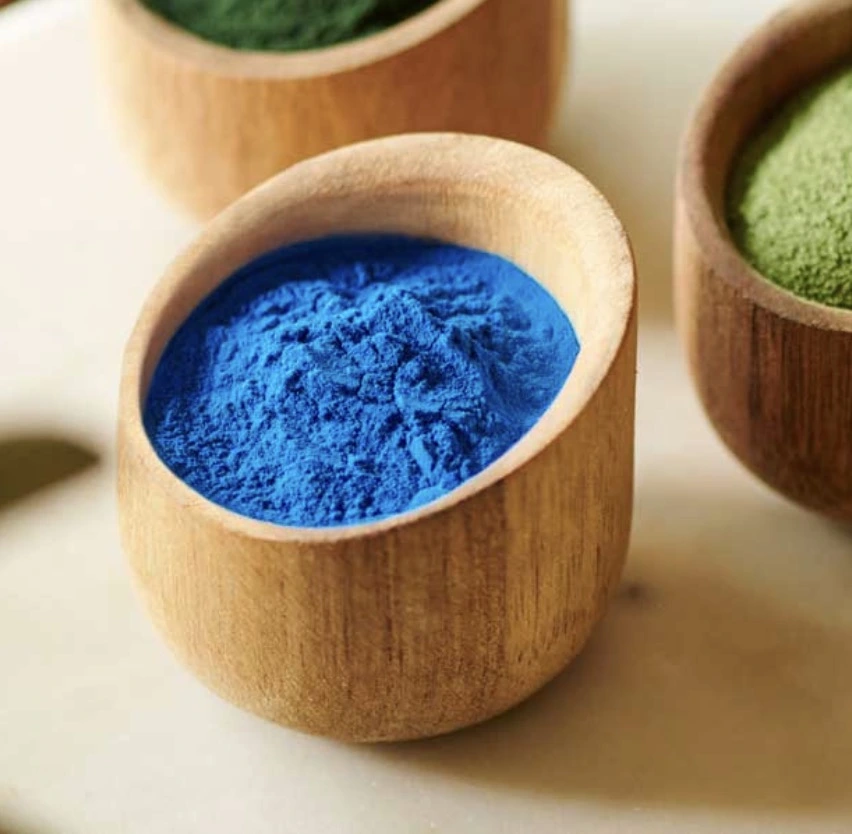Nutritional Profile of Blue Spirulina Powder
The nutritional profile of blue spirulina powder is outstandingly impressive, making it a profoundly sought-after superfood fixing. Not at all like its more common green partner, blue spirulina derives its dynamic color and numerous of its unique properties from phycocyanin, a capable pigment-protein complex. This powder is stuffed with a total protein source, meaning it contains all nine basic amino acids. It's also an outstanding source of vitamins, especially B vitamins, vitamin K, and vitamin E. Moreover, blue spirulina offers fundamental minerals like copper, iron, and manganese. Crucially, its antioxidant substance, essentially from phycocyanin, contributes to its potential health-promoting impacts. This combination of macronutrients, micronutrients, and bioactive compounds positions blue spirulina powder as a profitable expansion to a wide range of nourishment and refreshment applications, from smoothies and juices to prepared products and confectionery. The bioavailability of these supplements is also generally considered to be high, advancing their wholesome appeal.
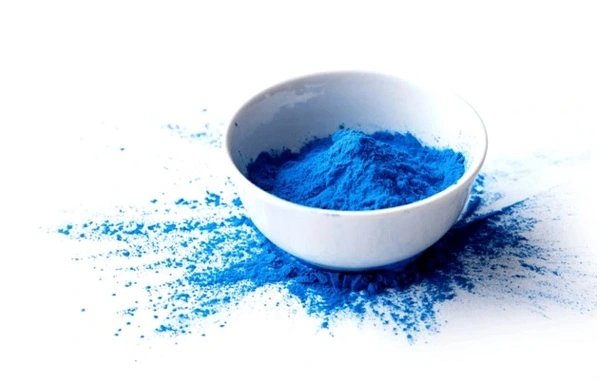
Introduction to Blue Spirulina Powder
Blue spirulina, with its captivating azure hue, has quickly transitioned from a specialty fixing to a standard superfood sensation. But what precisely is it, and how does it differ from the more recognizable green spirulina? This segment will delve into the beginnings, extraction handle, and key characteristics that characterize blue spirulina powder.
Origins and Botanical Background
Blue spirulina, at its core, is inferred from Arthrospira platensis, the same cyanobacterium (often alluded to as blue-green algae) that yields conventional green spirulina. Be that as it may, the vital contrast lies in the particular compounds that are disconnected and concentrated. Whereas green spirulina contains the whole, dried biomass of the algae, blue spirulina centers essentially on extracting the phycocyanin. Arthrospira platensis flourishes in soluble, freshwater situations, frequently found in warm climates around the world. Truly, it has been expended for centuries by different societies, especially in districts where it develops, actually, such as around Lake Chad in Africa. The development of spirulina for commercial purposes now happens in carefully controlled, open-pond frameworks or closed photobioreactors, guaranteeing virtue and ideal development conditions. These controlled situations minimize the risk of defilement and permit reliable generation of high-quality biomass.
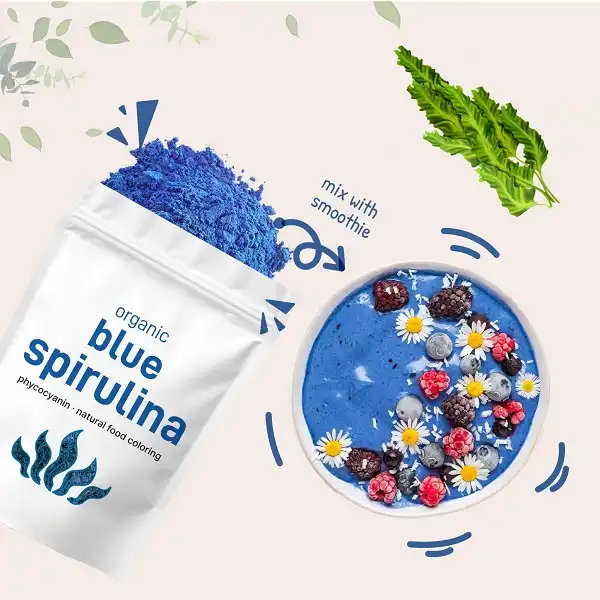
The Extraction Process of Phycocyanin
The striking blue color of blue spirulina powder comes entirely from phycocyanin, a phycobiliprotein. The extraction of phycocyanin is a delicate process designed to preserve its structural integrity and antioxidant activity. It typically involves several key steps:
- Cell Disruption: The Arthrospira platensis cells are first broken open to discharge their substance. This can be accomplished through different strategies, counting mechanical disruption (like high-pressure homogenization or bead processing), enzymatic lysis (using proteins to break down the cell walls), or osmotic shock (utilizing changes in salt concentration to rupture the cells).
- Extraction: Once the cells are disturbed, the phycocyanin is extracted utilizing water or a gentle fluid arrangement. This step is significant for isolating the phycocyanin from other cellular components, such as chlorophyll and other colors.
- Purification: The crude phycocyanin extract then experiences filtration steps to expel any remaining cellular flotsam and jetsam and undesirable compounds. These steps may include filtration, centrifugation, chromatography, or film partition strategies.
- Concentration and Drying: At long last, the filtered phycocyanin arrangement is concentrated and dried to deliver the last blue spirulina powder. Tender drying strategies, such as splash drying or freeze-drying, are favored to minimize heat corruption of the phycocyanin.
Distinguishing Features and Sensory Profile
Beyond its vibrant color, blue spirulina powder has a few recognizable characteristics. Not at all like green spirulina, which regularly has a solid, somewhat fishy or seaweed-like flavor and aroma, blue spirulina is for the most part portrayed as having a much milder, nearly unbiased taste. This makes it much more flexible for culinary applications, as it won't overwhelm other flavors. The surface is regularly a fine, free-flowing powder that scatters effortlessly in liquids. The color concentration can shift depending on the phycocyanin concentration, which is regularly standardized in commercial items (e.g., phycocyanin E10 refers to a particular color esteem). The need for a strong flavor profile, combined with the brilliant blue hue, makes blue spirulina a well-known choice for actually coloring nourishments and refreshments, including visual offers without modifying the taste essentially. It's a sought-after fixing for dynamic smoothies, smoothie bowls, lattes, sweets, and indeed savory dishes.
Rich Source of Essential Nutrients
Blue spirulina powder isn't just visually appealing; it's a nutritional powerhouse. This section will explore the diverse array of essential nutrients packed within this vibrant superfood, highlighting its macro- and micronutrient contributions.
Macronutrient Composition (Beyond Protein)
Whereas blue spirulina is renowned for its protein substance (discussed in the following segment), its macronutrient profile expands past fair protein. It also contains carbohydrates and a little amount of healthy fats. The carbohydrates in blue spirulina are basically complex carbohydrates, counting polysaccharides that may have prebiotic effects, supporting intestine wellbeing. These polysaccharides are gradually processed, giving a supported discharge of vitality. The fat substance in blue spirulina is generally low, but it's critical to note that it contains some fundamental greasy acids, counting gamma-linolenic acid (GLA), an omega-6 fatty acid with potential anti-inflammatory properties. The exact extents of carbohydrates and fats can shift marginally depending on the development and handling strategies.
Micronutrient Density and Bioavailability
Blue spirulina boasts a noteworthy micronutrient thickness, meaning it gives a critical amount of vitamins and minerals relative to its calorie substance. This is especially vital for people seeking to upgrade their supplement admissions without expending excessive calories. Besides, the supplements in blue spirulina are generally considered to be profoundly bioavailable, meaning they are promptly absorbed and utilized by the body. This is incompletely due to the common form of the supplements and the nonappearance of anti-nutritional variables that can sometimes prevent retention in other plant-based nourishments. The cell divider of Arthrospira platensis is effectively edible, permitting effective discharge of the supplements during digestion.
Comparing Nutritional Profiles: Blue vs. Green Spirulina
While both blue and green spirulina are derived from the same cyanobacterium, their nutritional profiles differ due to the emphasis on phycocyanin extraction in blue spirulina. Green spirulina contains the entire dried biomass, resulting in higher levels of chlorophyll, fiber, and certain minerals like iron. Blue spirulina, being primarily phycocyanin, has a relatively higher concentration of this specific pigment-protein complex and may have lower levels of some other nutrients found in green spirulina. However, the milder taste and vibrant color of blue spirulina often make it a more palatable and versatile option for food and beverage applications. The choice between blue and green spirulina depends on the desired application and nutritional goals. If the primary goal is to obtain phycocyanin and a neutral flavor, blue spirulina is the preferred choice. If a broader range of nutrients, including chlorophyll and higher iron content, is desired, green spirulina might be more suitable.
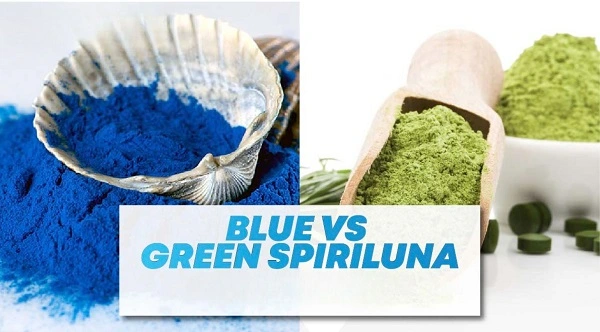
Protein Content and Amino Acid Profile
A defining characteristic of blue spirulina powder, and indeed all spirulina, is its exceptional protein content. This section will delve into the quantity and quality of protein found in blue spirulina, examining its amino acid profile and its significance for various dietary needs.
Protein Quantity: A Complete Plant-Based Source
Blue spirulina powder is remarkably protein-rich, with protein often comprising 55-70% of its dry weight. This makes it one of the most concentrated plant-based protein sources available, surpassing even other protein-dense foods like soybeans, lentils, and quinoa. This high protein content is particularly significant for vegetarians, vegans, and individuals seeking to increase their protein intake from plant-based sources. It also makes blue spirulina a valuable ingredient for sports nutrition products, meal replacements, and functional foods aimed at enhancing satiety and supporting muscle growth and repair.
Amino Acid Profile: All Essential Amino Acids Present
Crucially, the protein in blue spirulina is considered a "complete" protein, meaning it contains all nine essential amino acids that the human body cannot synthesize on its own and must obtain from dietary sources. These essential amino acids are: histidine, isoleucine, leucine, lysine, methionine, phenylalanine, threonine, tryptophan, and valine. The presence of all essential amino acids in blue spirulina is a significant advantage over many other plant-based protein sources, which are often deficient in one or more essential amino acids (typically lysine or methionine). This completeness makes blue spirulina a valuable addition to diets that may be lacking in certain essential amino acids.
Digestibility and Bioavailability of Spirulina Protein
The digestibility of protein is a crucial factor in determining its nutritional value. Fortunately, the protein in blue spirulina is highly digestible. The cell wall of Arthrospira platensis is relatively fragile and easily broken down by digestive enzymes, allowing for efficient access to the protein within. Studies have shown that the protein digestibility of spirulina is comparable to that of other high-quality protein sources like eggs and casein. This high digestibility, combined with the complete amino acid profile, ensures that the body can effectively utilize the protein from blue spirulina for various physiological functions, including muscle building, tissue repair, enzyme production, and hormone synthesis. The bioavailability is also enhanced by the absence of common allergens or anti-nutritional factors often found in other protein sources.
Antioxidant Properties and Benefits
Beyond its impressive macro- and micronutrient profile, blue spirulina powder is celebrated for its potent antioxidant properties. This section will explore the primary antioxidant compounds present, their mechanisms of action, and the potential health benefits associated with their antioxidant activity.
Phycocyanin: The Star Antioxidant
The dominant antioxidant in blue spirulina is, unsurprisingly, phycocyanin. This vibrant blue pigment-protein complex is responsible for the majority of blue spirulina's antioxidant activity. Phycocyanin is a phycobiliprotein, a family of light-harvesting proteins found in cyanobacteria and some algae. Its unique structure allows it to effectively scavenge free radicals and protect cells from oxidative damage. Phycocyanin spirulina extracts have demonstrated significant antioxidant capacity in various in vitro and in vivo studies. The antioxidant power of phycocyanin is often compared to that of other well-known antioxidants, such as vitamin C and vitamin E.
Mechanisms of Antioxidant Action
Phycocyanin, and other antioxidants present in blue spirulina, work through several mechanisms to neutralize free radicals and protect cells:
- Free Radical Scavenging: Phycocyanin can directly interact with free radicals, donating electrons to stabilize them and prevent them from causing cellular damage. Free radicals are unstable molecules with unpaired electrons that can damage DNA, proteins, and lipids, contributing to aging and various diseases.
- Inhibition of Oxidative Enzymes: Some antioxidants can inhibit the activity of enzymes that generate free radicals, such as NADPH oxidase and xanthine oxidase.
- Chelation of Metal Ions: Certain antioxidants can bind to metal ions, such as iron and copper, that can catalyze the formation of free radicals.
- Enhancement of Endogenous Antioxidant Defenses: Some antioxidants can stimulate the body's own antioxidant defense systems, increasing the production of enzymes like superoxide dismutase (SOD), catalase (CAT), and glutathione peroxidase (GPx).
Beyond Phycocyanin: Other Antioxidant Compounds
While phycocyanin is the primary antioxidant in blue spirulina, other compounds also contribute to its overall antioxidant capacity. These include:
- Beta-carotene: A precursor to vitamin A, beta-carotene is a potent antioxidant that protects against cellular damage.
- Vitamin E: A fat-soluble antioxidant that protects cell membranes from lipid peroxidation.
- Phenolic compounds: Blue spirulina contains various phenolic compounds, which have demonstrated antioxidant activity.
- Superoxide Dismutase (SOD): Spirulina naturally contains SOD, an enzyme that catalyzes the dismutation of superoxide radicals into less harmful oxygen and hydrogen peroxide.
Vitamins and Minerals in Blue Spirulina
Blue spirulina powder is not only a source of protein and antioxidants but also provides a range of essential vitamins and minerals. This section will detail the key vitamins and minerals found in blue spirulina, their functions in the body, and their contribution to overall health.
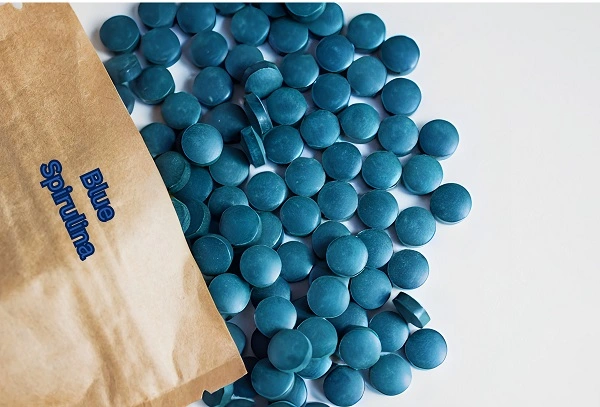
B-Vitamin Complex
Blue spirulina is a notable source of several B vitamins, including:
- Thiamin (B1): Essential for carbohydrate metabolism and nerve function.
- Riboflavin (B2): Plays a role in energy production and cellular function.
- Niacin (B3): Important for energy metabolism, DNA repair, and cell signaling.
- Pyridoxine (B6): Involved in protein metabolism, neurotransmitter synthesis, and immune function.
- Folate (B9): Crucial for cell growth and division, particularly important during pregnancy.
It is important, to note, that blue spirulina generally does not contain a significant amount of vitamin B12.While some forms of spirulina may contain analogs of B12, these are not bioavailable to humans and may even interfere with the absorption of true B12. Therefore, individuals relying on plant-based diets should not consider spirulina a reliable source of B12.
Other Key Vitamins
In addition to B vitamins, blue spirulina contains other vitamins, including:
- Vitamin K: Essential for blood clotting and bone health.
- Vitamin E: A fat-soluble antioxidant that protects cell membranes.
Essential Minerals
Blue spirulina provides several essential minerals, including:
- Copper: A cofactor for various enzymes involved in energy production, iron metabolism, and connective tissue formation.
- Iron: Essential for oxygen transport in red blood cells and energy production. Note that the iron in blue spirulina is non-heme iron, which is less readily absorbed than heme iron found in animal products. Consuming vitamin C alongside blue spirulina can enhance iron absorption.
- Manganese: A cofactor for enzymes involved in antioxidant defense, bone formation, and metabolism.
- Potassium: crucial for regulating the body's water balance and supporting nervous system function.
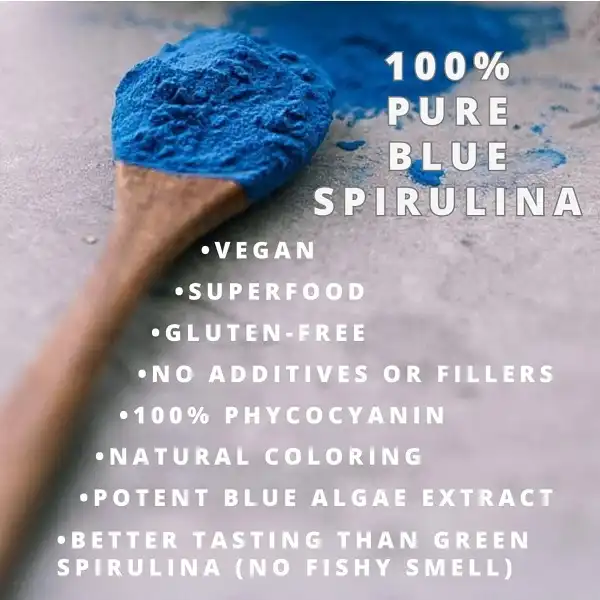
Potential Health Benefits of Regular Consumption
The impressive nutritional profile of blue spirulina powder translates into a range of potential health benefits. This section will explore the evidence-based benefits associated with regular consumption of blue spirulina, focusing on areas supported by scientific research.
Supporting Immune Function
The combination of antioxidants, vitamins, minerals, and protein in blue spirulina may contribute to supporting a healthy immune system. Phycocyanin, in particular, has shown immunomodulatory effects in some studies, potentially enhancing the activity of certain immune cells. The vitamins and minerals present also play crucial roles in immune function. For instance, vitamin C and zinc are well-known for their roles in supporting immune cell activity and protecting against infections. However, more research is needed to fully understand the specific effects of blue spirulina on human immune function.
Anti-Inflammatory Effects
Chronic inflammation is implicated in a wide range of diseases. Phycocyanin, the key antioxidant in blue spirulina, has demonstrated anti-inflammatory properties in various studies. It may help to reduce inflammation by inhibiting the production of pro-inflammatory molecules and enzymes. Gamma-linolenic acid (GLA), an omega-6 fatty acid found in small amounts in blue spirulina, also possesses anti-inflammatory properties. While more research is needed to confirm these effects in humans, the existing evidence suggests that blue spirulina may have a role in managing inflammation.
Exercise Performance and Recovery
The high protein content, antioxidants, and other nutrients in blue spirulina may benefit exercise performance and recovery. Protein is essential for muscle repair and growth, while antioxidants can help to combat oxidative stress caused by intense exercise. Some studies have suggested that spirulina supplementation may improve endurance, reduce muscle fatigue, and enhance recovery. However, the research in this area is still preliminary, and more studies are needed to determine the optimal dosage and timing of blue spirulina consumption for athletic performance. The iron content, while not as bioavailable as heme iron, may also contribute to improved oxygen transport, potentially benefiting endurance athletes.

Conclusion
Blue spirulina powder stands out as a nutritional marvel, offering a concentrated source of protein, essential amino acids, antioxidants, vitamins, and minerals. Its unique composition, particularly its high phycocyanin content, positions it as a valuable ingredient for enhancing the nutritional profile of various food and beverage products. While further research continues to explore its full range of potential health benefits, the existing evidence suggests that blue spirulina can be a valuable addition to a healthy diet, supporting immune function, reducing inflammation, and potentially aiding exercise performance.
Yangge Biotech Co., Ltd. is a leading supplier of high-quality, natural plant extracts, including premium blue spirulina powder. We are committed to providing our customers with innovative and reliable ingredient solutions. Our blue spirulina is meticulously sourced and processed to ensure maximum purity and potency, preserving the valuable phycocyanin and other nutrients. We adhere to strict quality control standards, backed by ISO, HACCP, Kosher, and Halal certifications. Our dedicated R&D and production teams, along with our 24-hour online service, ensure that we meet your specific needs and provide exceptional customer support. Choose Yangge Biotech for your blue spirulina powder needs and experience the difference in quality and service. Contact us today to learn more: info@yanggebiotech.com.
FAQ
Q: Can we get some samples to test before purchasing?
A: Of course, we can provide free samples of 20 to 100 grams, but the shipping cost is at the customer's expense. The shipping cost can be deducted from the next order, or the samples can be sent through your courier account.
Q: Do your products have relevant certifications?
A: Yes, our products are certified for HALAL, ISO, HACCP, Kosher, and other certifications.
Q: What is the minimum order quantity (MOQ)?
A: Small batches of samples can be customized according to your requirements.
Q: Do you offer OEM and ODM services? Can the formula be customized based on our own?
A: Of course, we provide ODM and OEM services to many customers. Our product range includes softgels, capsules, tablets, sachets, granules, and private label services. Simply contact us and let us know your requirements. Our experienced R&D team can also develop new products with specific formulas.
Please contact us to design your own branded products.
Q: How do you handle quality complaints?
A: First, we have a comprehensive quality control SOP. We provide authoritative third-party inspection reports for almost all products before shipment to minimize the possibility of quality issues. Second, we have a comprehensive return and exchange procedure. If there is a genuine quality dispute, we will strictly follow the SOP.
Q: How do you ship? How long does delivery take?
A: For small orders, we typically use DHL, UPS, EMS, FedEx, or TNT. Delivery typically takes 3-7 days. We also offer air and sea freight services. We have a strong freight forwarding team and can provide you with a one-stop service, including DDP and DDU.
Q: What are your payment terms?
A: 100% prepayment, payable by T/T, Western Union, MoneyGram, or PayPal.
Q: What is the shelf life of your products?
A: 2 years with proper storage.
Q: Is the packaging environmentally friendly?
A: We attach great importance to environmental protection and are constantly improving our product packaging. Some products are packaged in recyclable paper. Packaging materials are carefully selected to ensure product safety during transportation and storage, and to minimize environmental impact. We are committed to achieving a balance between environmental friendliness and practicality in our product packaging, and to contributing to sustainable development.
References
1. Karkos, P. D., Leong, S. C., Karkos, C. D., Sivaji, N., & Assimakopoulos, D. A. (2011). Spirulina in Clinical Practice: Evidence-Based Human Applications. Evidence-based complementary and alternative medicine : eCAM, 2011, 531053.
2. Wu, Q., Liu, L., Miron, A., Klímová, B., Wan, D., & Kuča, K. (2016). The antioxidant, immunomodulatory, and anti-inflammatory activities of Spirulina: an overview. Archives of toxicology, 90(8), 1817–1840.
3. Chamorro, G., Salazar, M., Favila, L., & Bourges, H. (1996). Farmacología y toxicología de Spirulina [Pharmacology and toxicology of Spirulina]. Archivos Latinoamericanos de Nutricion, 46(3), 313-319.
4. Deng, R., & Chow, T. J. (2010). Hypolipidemic, antioxidant, and antiinflammatory activities of microalgae Spirulina. Cardiovascular therapeutics, 28(4), e33–e45.
5. Pérez, V. L., Figueroa, C. M. V., & Iñiguez, J. F. (2009). Spirulina: Superalimento del Futuro [Spirulina: Superfood of the Future]. Universidad Nacional Autónoma de México.
6. Belay A. (2002). The potential application of Spirulina (Arthrospira) as a nutritional and therapeutic supplement in health management. The Journal of the American Nutraceutical Association, 5(2), 27–48.

Based on your location and order quantity, you will have the opportunity to receive a limited time free shipping promotion!
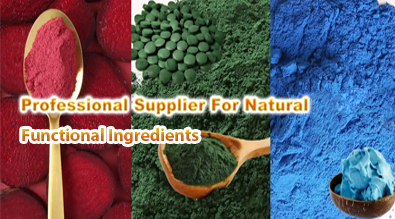
Who we are

